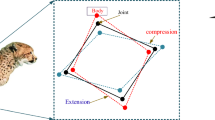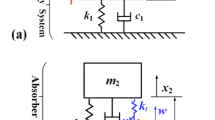Abstract
Vibration testing is necessary for functionality and durability evaluations of equipment that may undergo performance degradation due to operational vibrations. Here, we propose a planning method for the vibration testing of equipment with high slenderness ratios, such as missiles, and excitation, support, and measurement locations are important factors for the test configuration. A finite element model was used to calculate the normal modes and suitability indexes, based on the excitation and support locations. The measurement locations were obtained via the effective-independence method. Indexes of the response of dominant modes to excitation were generated for each surface through vibration testing involving various excitation, support, and measurement locations. The suitability indexes of excitation and support locations, exhibited a high correlation with the indexes of response magnitude in the dominant modes of the equipment. Therefore, the vibration test configuration can be planned effectively by exciting dominant modes of equipment under test.
Similar content being viewed by others
References
MIL-STD-810H (Environmental Engineering Considerations and Laboratory Tests), 514.8D-14, Department of Defense, USA (dy2019).
DEF STAN 00-35 (Environmental Handbook for Defense Materiel), Part5 Issue4 Chapter7-01, Ministry of Defence, UK (2006) 124–125.
MIL-STD-810H (Environmental Engineering Considerations and Laboratory Tests), 523.4-4, Department of Defense, USA (2019).
C. Roberts and D. Ewins, Multi-axis vibration testing of an aero dynamically excited structure, Journal of Vibration and Control, 24 (2) (2016) 428.
N. Imamovic, Validation of large structural dynamics models using modal test data, Doctorial Thesis, Imperial College of Science, Technology and Medicine, University of London (1998).
H. Hidalgo Jr., An innovative structural mode selection methodology: Application for the X-33 launch vehicle finite element model, AIAA-2000-1587} (2000) 1.
A. Verhaegen and R. Zbikowski, Aeroservoelastic modelling and control of a slender anti-air missile for active damping of longitudinal bending vibrations, Aerospace Science and Technology, 66 (2017) 9.
MIL-STD-810H (Environmental Engineering Considerations and Laboratory Tests), 514.8-20, Department of Defense, USA (2019).
H. Hidalgo Jr., An innovative structural mode selection methodology: Application for the X-33 launch vehicle finite element model, AIAA-2000-1587 (2000) 2.
D. J. Ewins, Modal Testing-theory, Practice and Application, Research Studies Press, UK (2000) 510.
MIL-STD-810H (Environmental Engineering Considerations and Laboratory Tests), 514.8-20, Department of Defense, USA (2019).
D. J. Inman, Engineering Vibration, Pearson, UK (2014) 610.
D. J. Ewins, Modal Testing-theory, Practice and Application, Research Studies Press, UK (2000) 509.
D. C. Kammer, Sensor placement for on-orbit modal identification and correlation of large space structures, Journal of Guidance, Control and Dynamics, 14 (2) (1991) 251–259.
T. Yi and H. Li, Methodology developments in sensor placement for health monitoring of civil infrastructures, International Journal of Distributed Sensor Networks (2012) 8.
P. M. Daborn, P. R. Ind and D. J. Ewins, Enhanced ground-based vibration testing for aerodynamic environments, Mechanical Systems and Signal Processing, 49 (2014) 166.
MIL-STD-810H (Environmental Engineering Considerations and Laboratory Tests), 527.2-2, Department of Defense, USA (2019).
H. Vold, J. Crowley and G. T. Rocklin, New ways of estimating frequency response functions, Sound and Vibration, 18 (1984) 34–38.
D. L. Brown, R. J. Allemang, R. Zimmerman and M. Mergeay, Parameter estimation techniques for modal analysis, SAE Transactions, 88 (1) (1979) 828–846.
P. Avitabile, Modal Testing-a Practitioner’s Guide, Wiley, New Jersey, USA (2018) 208.
Acknowledgments
This research was supported by the Infrastructure Building Program through the Korea Agency for Infrastructure Technology Advancement (KAIA), which is funded by the Ministry of Land, Infrastructure and Transport (19CTAP-C153014-01-000000).
Author information
Authors and Affiliations
Corresponding author
Additional information
Recommended by Associate Editor Dongho Oh
Inki Park received a B.S. degree from Korea Aviation University in 1997 and an M.S. degree from Hanyang University in 2002. He is currently a researcher at the Agency for Defense Development, and a Ph.D. candidate at the Graduate School of Hanyang University. His research interest is the environmental vibration test method for a large EUT.
Junhong Park received B.S. and M.S. degrees from the Korea Advanced Institute of Science and Technology (KAIST) in 1991 and 1993, respectively. He received a Ph.D. degree from Purdue University in 2002. He is currently a Professor of Mechanical Engineering at Hanyang University. His research interests are signal processing, wave analysis, and noise control for improving the acoustic comfort of automobiles, trains, and residential buildings.
Rights and permissions
About this article
Cite this article
Park, I., Park, J. Effective vibration test planning method for equipment with high slenderness ratio. J Mech Sci Technol 33, 5779–5786 (2019). https://doi.org/10.1007/s12206-019-1124-1
Received:
Revised:
Accepted:
Published:
Issue Date:
DOI: https://doi.org/10.1007/s12206-019-1124-1




